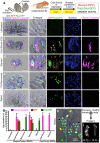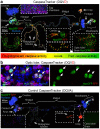In vivo CaspaseTracker biosensor system for detecting anastasis and non-apoptotic caspase activity
- PMID: 25757939
- PMCID: PMC4355673
- DOI: 10.1038/srep09015
In vivo CaspaseTracker biosensor system for detecting anastasis and non-apoptotic caspase activity
Abstract
The discovery that mammalian cells can survive late-stage apoptosis challenges the general assumption that active caspases are markers of impending death. However, tools have not been available to track healthy cells that have experienced caspase activity at any time in the past. Therefore, to determine if cells in whole animals can undergo reversal of apoptosis, known as anastasis, we developed a dual color CaspaseTracker system for Drosophila to identify cells with ongoing or past caspase activity. Transient exposure of healthy females to environmental stresses such as cold shock or starvation activated the CaspaseTracker coincident with caspase activity and apoptotic morphologies in multiple cell types of developing egg chambers. Importantly, when stressed flies were returned to normal conditions, morphologically healthy egg chambers and new progeny flies were labeled by the biosensor, suggesting functional recovery from apoptotic caspase activation. In striking contrast to developing egg chambers, which lack basal caspase biosensor activation under normal conditions, many adult tissues of normal healthy flies exhibit robust caspase biosensor activity in a portion of cells, including neurons. The widespread persistence of CaspaseTracker-positivity implies that healthy cells utilize active caspases for non-apoptotic physiological functions during and after normal development.
Figures




Similar articles
-
Detecting Anastasis In Vivo by CaspaseTracker Biosensor.J Vis Exp. 2018 Feb 1;(132):54107. doi: 10.3791/54107. J Vis Exp. 2018. PMID: 29443051 Free PMC article.
-
In Vivo Biosensor Tracks Non-apoptotic Caspase Activity in Drosophila.J Vis Exp. 2016 Nov 27;(117):53992. doi: 10.3791/53992. J Vis Exp. 2016. PMID: 27929458 Free PMC article.
-
Strategies for tracking anastasis, a cell survival phenomenon that reverses apoptosis.J Vis Exp. 2015 Feb 16;(96):51964. doi: 10.3791/51964. J Vis Exp. 2015. PMID: 25742050 Free PMC article.
-
Nerve-racking - apoptotic and non-apoptotic roles of caspases in the nervous system of Drosophila.Eur J Neurosci. 2016 Jul;44(1):1683-90. doi: 10.1111/ejn.13213. Epub 2016 Mar 19. Eur J Neurosci. 2016. PMID: 26900934 Review.
-
Can't live without them, can live with them: roles of caspases during vital cellular processes.Apoptosis. 2009 Aug;14(8):980-95. doi: 10.1007/s10495-009-0346-6. Apoptosis. 2009. PMID: 19373560 Review.
Cited by
-
Coupled Caspase and N-End Rule Ligase Activities Allow Recognition and Degradation of Pluripotency Factor LIN-28 during Non-Apoptotic Development.Dev Cell. 2017 Jun 19;41(6):665-673.e6. doi: 10.1016/j.devcel.2017.05.013. Epub 2017 Jun 8. Dev Cell. 2017. PMID: 28602583 Free PMC article.
-
MOMP, cell suicide as a BCL-2 family business.Cell Death Differ. 2018 Jan;25(1):46-55. doi: 10.1038/cdd.2017.179. Epub 2017 Oct 20. Cell Death Differ. 2018. PMID: 29053143 Free PMC article. Review.
-
Do TUNEL and Other Apoptosis Assays Detect Cell Death in Preclinical Studies?Int J Mol Sci. 2020 Nov 29;21(23):9090. doi: 10.3390/ijms21239090. Int J Mol Sci. 2020. PMID: 33260475 Free PMC article. Review.
-
Anastasis: recovery from the brink of cell death.R Soc Open Sci. 2018 Sep 19;5(9):180442. doi: 10.1098/rsos.180442. eCollection 2018 Sep. R Soc Open Sci. 2018. PMID: 30839720 Free PMC article. Review.
-
Viability Assessment Following Anticancer Treatment Requires Single-Cell Visualization.Cancers (Basel). 2018 Aug 1;10(8):255. doi: 10.3390/cancers10080255. Cancers (Basel). 2018. PMID: 30071623 Free PMC article.
References
-
- Alnemri E. S. et al. Human ICE/CED-3 protease nomenclature. Cell 87, 171 (1996). - PubMed
-
- Riedl S. J. & Shi Y. Molecular mechanisms of caspase regulation during apoptosis. Nat Rev Mol Cell Biol 5, 897–907 (2004). - PubMed
-
- Chai J. & Shi Y. Apoptosome and inflammasome: conserved machineries for caspase activation. National Science Review 1, 101–118 (2013).
Publication types
MeSH terms
Substances
Grants and funding
LinkOut - more resources
Full Text Sources
Other Literature Sources
Molecular Biology Databases
Miscellaneous

